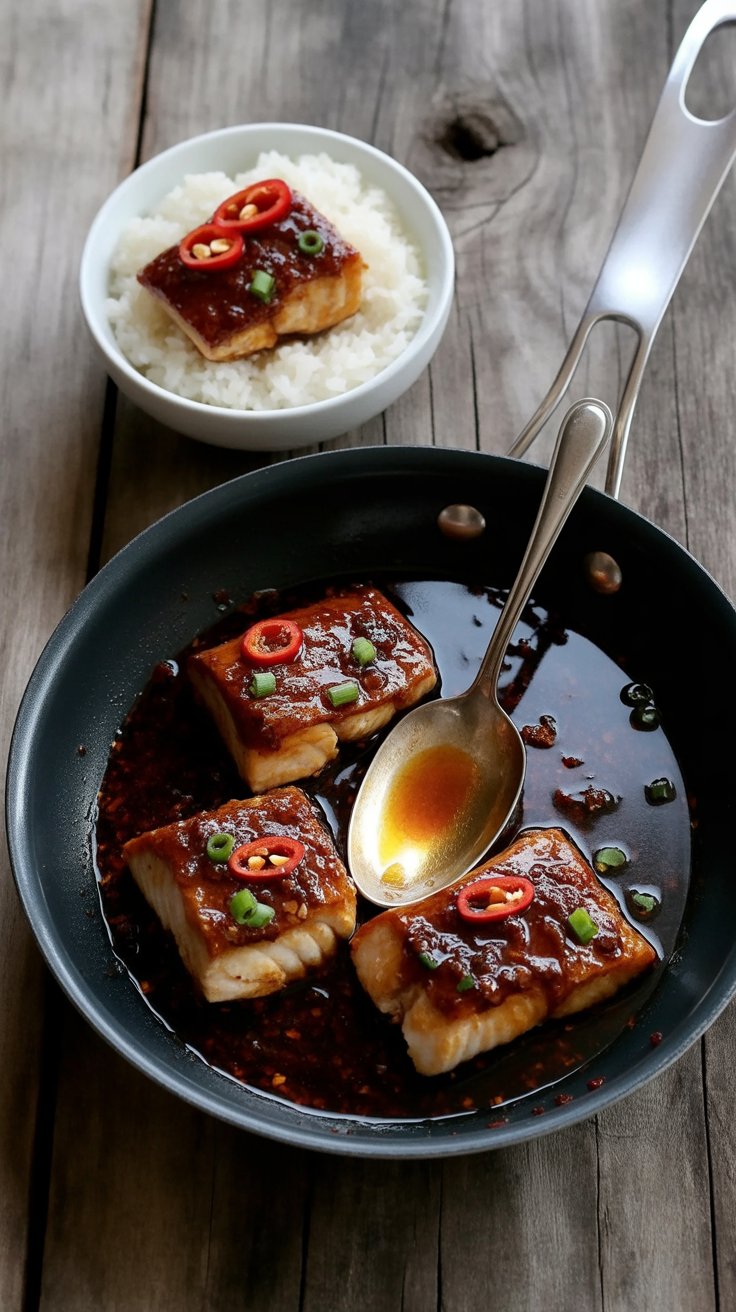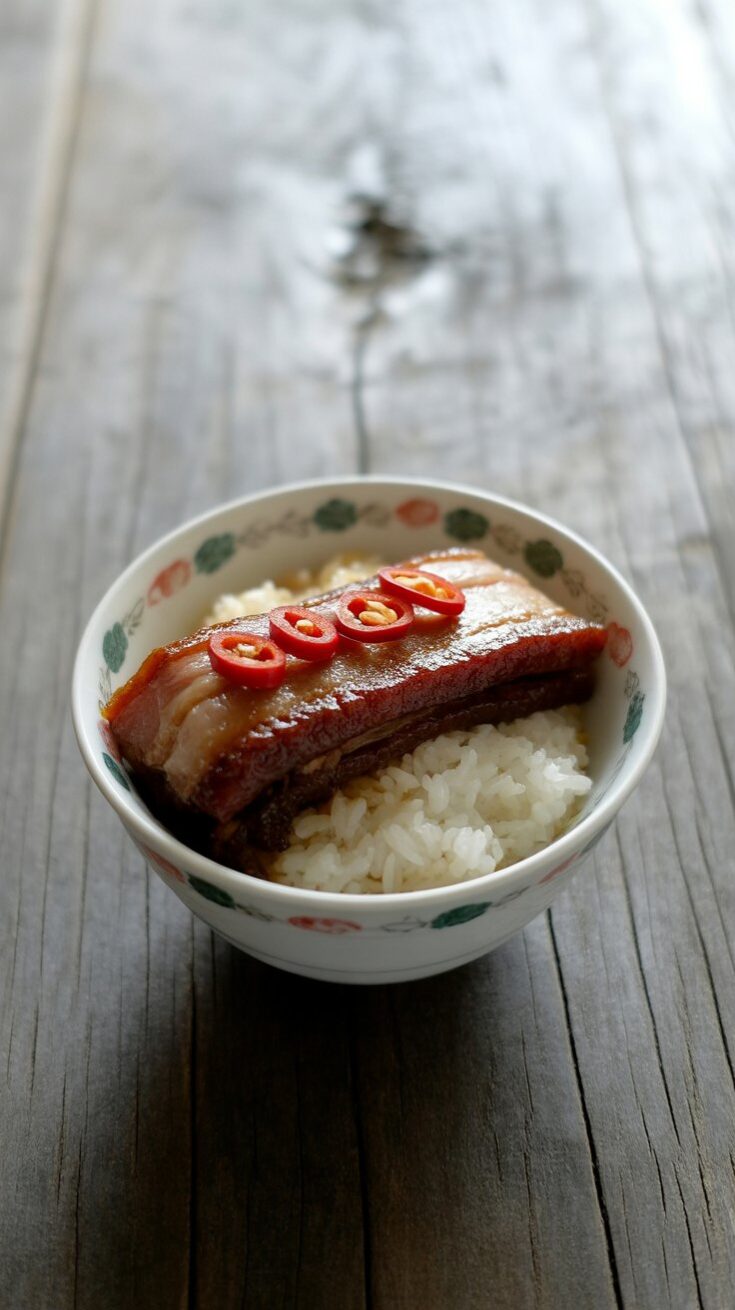When I think of true Vietnamese comfort food, cá kho instantly comes to mind. This dish—catfish braised in a sweet-savory caramel sauce with fish sauce, garlic, and pepper—is the kind of food that makes you want to sit down with a bowl of hot rice and eat slowly, savoring every bite. It’s rich, salty, a little sweet, and deeply satisfying.

Traditionally, this dish is cooked in a clay pot (the tộ in cá kho tộ), which gives it a rustic charm. But here’s the secret: even in restaurants back home, the fish is often cooked in a regular pan and then transferred to a clay pot for presentation. My mom admitted that her restaurant did exactly that, heating the pot before serving just to make it look authentic! At home, I skip the clay pot entirely and stick to a trusty non-stick pan—less fuss, same amazing flavor.
Why You’ll Love This Dish
This braised catfish is the kind of meal that makes you slow down at the dinner table. The sauce clings to every piece of fish and seeps into your rice, turning something so simple into a complete meal. It’s bold, salty, slightly sweet, and made for pairing with fresh vegetables or pickles to balance things out.
I love that it’s not a once-in-a-while recipe—it’s something you can make on a weeknight if you’ve got catfish on hand. In Vietnam, families eat it year-round, any time of day. For me, it’s a dish I crave whenever I want something soulful and hearty, the type of meal that makes me feel connected to family traditions.
Choosing the Right Fish
In Vietnam, snakehead fish (cá lóc) or catfish (cá trê) are common choices. They’re affordable and widely available there, though in the U.S., the frozen versions don’t quite do them justice. That’s why catfish fillets have become the go-to option here—they’re meaty, easy to find, and don’t have too many bones to fuss over.
Sometimes my family uses the whole fish, saving the head and tail for canh chua, a sour tamarind-based soup, while braising the thick fillets for cá kho. It’s a great way to make two meals from one fish.
Thoughts on Fish Sauce
Fish sauce is the backbone of this dish, so choosing a good one makes all the difference. I grew up with Three Crabs brand because that’s what my mom used, and naturally, I stuck with it for years. These days, I’ve been experimenting with premium Vietnamese fish sauces that use fewer additives—just fish, salt, and water. They taste cleaner, richer, and have less of the harsh edge some cheaper brands carry.
If you’re new to cooking with fish sauce, don’t be put off by the aroma. Once it hits the caramelized sugar and simmers with the catfish, it transforms into a complex, savory sauce that’s absolutely addictive.

How to Serve It
Cá kho is rich and salty, which is exactly why it pairs so beautifully with plain white rice and fresh sides. I like to keep it classic with:
-
Sliced cucumbers
-
Boiled or steamed greens (like water spinach or green beans)
-
Pickled mustard greens (dưa chua) for tangy contrast
The combination makes every bite balanced and satisfying. On a chilly evening, I’ve even paired this with a side of hot soup, and it feels like the kind of meal that keeps you warm from the inside out.
Tips From My Kitchen
-
Caramelize the sugar carefully—don’t let it burn, or the sauce will turn bitter. Pull it off the heat as soon as it turns a deep amber.
-
Use a non-stick or heavy-bottomed pan to keep the fish from sticking as it braises.
-
Don’t skip the cracked black pepper—it’s a signature flavor here.
-
Braise low and slow so the fish absorbs the sauce without falling apart.
-
Taste the sauce before finishing—you can always add a splash more fish sauce or sugar to balance it.
Storage and Reheating
Cá kho actually tastes even better the next day after the flavors have had more time to mingle. Store leftovers in an airtight container in the fridge for up to 3 days. Reheat gently on the stovetop over low heat—adding a splash of water if the sauce thickens too much.

Frequently Asked Questions
Can I use another type of fish besides catfish?
Yes, but choose firm, fatty fish like salmon or mackerel. Leaner fish can dry out during braising.
Do I need to use a clay pot?
Not at all. A non-stick skillet or Dutch oven works perfectly. The clay pot is mostly for presentation these days.
Is there a substitute for fish sauce?
There’s really no true replacement for fish sauce, but if you must, a mix of soy sauce and a little anchovy paste comes closest. Still, fish sauce is what makes this dish authentic.
Can I make this dish less salty?
Yes—use low-sodium fish sauce or add more sugar to balance the saltiness. Pairing with plenty of rice and vegetables also naturally tones it down.
Vietnamese Braised & Caramelized Catfish

A true Vietnamese comfort dish, this sweet, savory, and deeply flavorful braised fish is simmered in a rich caramelized sauce that begs to be paired with steaming hot white rice.
Ingredients
Fish
- 1 lb catfish fillets (skin and bones optional)
- Salt (to clean the fish)
Aromatics
- 2 tbsp oil
- 5 garlic cloves, minced
- ½ yellow onion, sliced
Sauce & Braising Liquid
- 1 tsp salt
- 1 ½ tbsp fish sauce
- ½ tsp thick soy sauce
- ½ cup water
- ½ cup coconut juice (or substitute with 1 cup coconut soda in place of water + juice)
- 1 chile, sliced (optional, adjust to taste)
- Freshly ground black pepper (to taste)
Garnish
- 1 green onion, roughly chopped
- 1 red chile, thinly sliced (optional)
- Extra black pepper
Instructions
- Rinse the catfish with salt and water to clean, then pat dry.
- Heat the oil in a wide pan over medium heat. Sauté the garlic until golden and fragrant. Layer sliced onions over the garlic, then place the fish fillets on top, spacing them evenly.
- Pour in the fish sauce, soy sauce, salt, water, coconut juice (or soda), and chile if using. Turn the heat to high and bring the mixture to a boil. Taste the sauce and adjust seasoning as needed.
- Lower the heat and let the fish simmer for about 20 minutes. Carefully flip the fillets, then continue simmering for another 10 minutes with the lid partially covered. During this time, spoon the sauce over the fish often to deepen the flavor and keep it from burning.
- In the last 2 minutes, add green onions to wilt. Garnish with fresh chile slices and black pepper before serving.
Notes
- Keep a close eye during the final simmering stage—the caramelized sauce can thicken quickly.
- Catfish is traditional, but basa, tilapia, or other firm white fish also work.
- Best enjoyed immediately with plenty of steamed jasmine rice to soak up the sauce.
Nutrition Information
Yield
2Serving Size
1Amount Per Serving Calories 664Total Fat 37gSaturated Fat 10gTrans Fat 0gUnsaturated Fat 23gCholesterol 150mgSodium 2999mgCarbohydrates 38gFiber 4gSugar 26gProtein 45g
Easy Shrimp Recipes.com, occasionally offers nutritional information for recipes contained on this site. This information is provided as a courtesy and is an estimate only. This information comes from online calculators. Although allchickenrecipes.com attempts to provide accurate nutritional information, these figures are only estimates.
Final Thought
Vietnamese Caramelized & Braised Catfish isn’t just a recipe—it’s a tradition, a reminder of family meals and shared bowls of rice. The caramelized sauce, the savory punch of fish sauce, and the tender fish make it unforgettable. Once you try it, you’ll see why it’s such a beloved dish in Vietnamese homes. It’s simple, soulful cooking at its best, and something you’ll want to make again and again.

